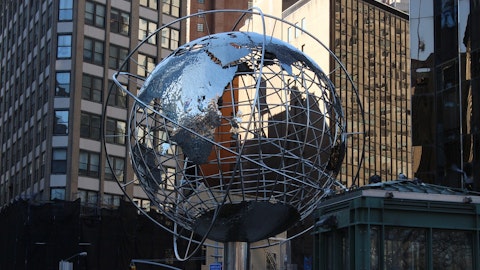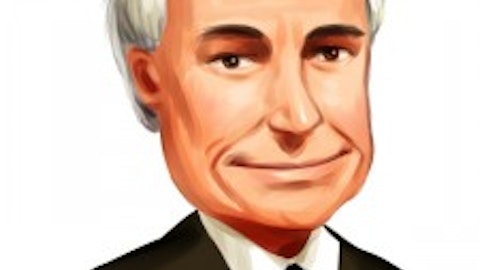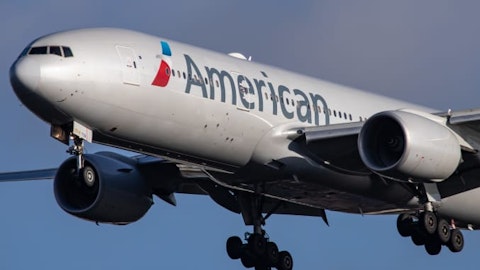Warner Bros. Discovery, Inc. (NASDAQ:WBD) Q2 2023 Earnings Call Transcript August 3, 2023
Warner Bros. Discovery, Inc. misses on earnings expectations. Reported EPS is $-0.51 EPS, expectations were $-0.39.
Operator: Ladies and gentlemen, welcome to the Warner Bros. Discovery Second Quarter 2023 Earnings Conference Call. [Operator Instructions] Additionally, please be advised that today’s conference call is being recorded. I would now like to hand the conference over to Mr. Andrew Slabin, Executive Vice President, Global Investor Strategy. Sir, you may now begin.
Andrew Slabin: Good morning and welcome to Warner Bros. Discovery’s Q2 earnings call. With me today is David Zaslav, President and CEO; Gunnar Wiedenfels, our CFO; and JB Perrette, CEO and President, Global Streaming and Games. Before we start, I’d like to remind you that today’s conference call will include forward-looking statements that we make pursuant to the safe harbor provisions of the Private is Litigation Reform Act of 1995. The forward-looking statements include comments regarding the company’s future business plans, prospects and financial performance. These statements are made based on management’s current knowledge and assumptions about future events and involve risks and uncertainties that could cause actual results to differ materially from our expectations.
In providing projections and other forward-looking statements, the company disclaims any intent or obligation to update them. For additional information on important factors that could affect these expectations, please see the company’s filings with the U.S. Securities and Exchange Commission, including but not limited to the company’s most recent annual report on Form 10-K and its reports on Form 10-Q and Form 8-K. A copy of our Q2 earnings release, trending schedule and accompanying slide deck will be available on our website at ir.wbd.com. And with that, I am pleased to turn the call over to David.
David Zaslav: Hello, everyone and thank you for joining us. When we merged the 2 legacy companies and formed Warner Bros. Discovery 16 months ago, we did so with the ambition to be the greatest media and entertainment company in the world. And we continue to carry out our attack plan in all areas of the business. When you look back at what we said we would do, we’re doing it. We said we were going to reimagine the company for the future and focus on free cash flow and delevering the balance sheet and we are. This quarter alone, we generated over $1.7 billion in free cash flow and we’re anticipating about the same in Q3. This is the result of the hard work of our teams, who have been bold, decisive and disciplined. We’ve restructured our businesses for the future to position them to drive both profitability and long-term growth.

scyther5/Shutterstock.com
And the results have been significant. And as a further sign of our confidence in our free cash flow capability, this morning we announced a tender for up to $2.7 billion of our short-dated debt. We paid down $1.6 billion in debt in Q2, bringing our total debt retirement, before today’s tender, to $9 billion since the merger. And as we’ve said, we expect to be comfortably below 4x levered by the end of the year, firmly within the investment-grade rating by midpoint next year and at our target of 2.5 to 3x gross leverage by the close of 2024. With our free cash flow and leverage targets in sight, we are better positioned to lean into top line growth opportunities across the company and that’s increasingly been our focus, starting with direct consumer.
We said we were going to build a strong, sustainable direct-to-consumer strategy focused on profitable growth as opposed to chasing subs at any cost. And we are. In fact, we continue to track way ahead of our own financial projections. And as we told you last quarter, we expect our U.S. direct-to-consumer business to be profitable for the year 2023, this year, a year ahead of our prior guidance. In fact, our global direct-to-consumer business was roughly breakeven in Q2 and modestly EBITDA positive for the first half of this year. And our U.S. direct-to-consumer business is generating healthy EBITDA which is helping to offset international losses, even with the product development costs and sizable marketing campaign associated with the launch of Max.
The migration to Max has gone exceedingly well with the overwhelming majority of subscribers in the U.S. successfully transferred. While we have seen some expected subscriber disruption, we have experienced lower-than-expected churn throughout this process. And by all measures, the third-party metrics, the consumer experience is top notch. The most important metric at this stage, only 2 months into our launch, is the amount of time people are spending watching our content. And we’re seeing early and encouraging signs of stronger engagement. And they’re not only watching for longer, also exploring new genres, adventure and discovery, true crime, home improvement and other nonfiction content. The mix of blockbuster originals from HBO, together with the nourishment and great personalities found on discovery+ content, makes for a very compelling content proposition.
Truly something for everyone. We’re preparing to launch Max in markets around the globe over the next year plus. There is significant opportunity internationally in markets we have yet to attack. And importantly, the platform now has full capability to deliver live programming. We’ll have more to say about that soon. While Max will be a cornerstone of our company’s growth, we also see great potential across a number of our other businesses. One is gaming. We’re the only company among our peers scaled in gaming. Next up is Mortal Combat 1, the highly anticipated new title in the acclaimed 30-year franchise set for release next month. This comes on the heels of the success of Hogwarts Legacy which is still the biggest game of 2023. And there’s more planned, including the one of Hogwarts Legacy on the Nintendo Switch in November, just in time for the holidays.
More broadly, we are positioning our gaming business to be a much more strategic piece of our IP and consumer engagement puzzle and we’re investing accordingly. At Warner Bros. Discovery, we’re one of the largest makers and sellers of content in the world. And it’s quality content people want to watch. We had an industry-leading 181 Emmy nominations, including 127 for HBO and Max, the most of any network for platform. As a critical supplier of some of the most highly resonant television series, we are adding incremental asset value to our world-class portfolio. And as we window that content around the globe, we expect to continue to see a tailwind of growth in our production business. Likewise, we have real ambition for the future of our motion picture business in the wake of the creative tour de force and global cultural phenomenon that is Barbie.
While the studio’s performance has been challenged in recent years and they’ve clearly under-earned their potential, we are taking meaningful steps with respect to the creative direction of both Warner Bros. Pictures Group and DC. And a key facet of this strategy will be to lean into some of our great underutilized storytelling IP. It’s been 10 years since we made a stand-alone Superman movie and 9 years since the last Lord of the Rings, for example. For many years, the secret to Warner Bros. profitability was tenpole films. They’d make 2 to 3 of them together with a slate of new original content and that was the winning formula. We too believe in the power of tentpoles, featuring great IP recognized by people everywhere in the world. our core strength and we intend to get back to doing what we know works.
While we’ve still got lots to do, we’re very optimistic about the growth potential of this business. The culmination of what we’re winning at both our film and television studios is further bolstering what is already among the industry’s biggest film and TV libraries. And this asset offers a wealth opportunity in terms of feeding our own platforms as well as others. It’s a mainstay of our business to create great content and window it through, creating value in each window. And as you would expect, a lot of analysis and strategic discussion goes into these decisions. In some cases, we’ll want to keep premium content exclusively on our platform for a very long time. In other cases, we may sell it to third parties and we don’t lose anything by growing the pie.
The fact is licensing some library content to other SVOD platforms, like Netflix or Amazon, as part of a co-exclusive agreement is just smart business. We’re expanding our audience while maximizing the value of the asset and providing more revenue streams. And that is our job, To optimize the windowing to get the best possible return on investment. We’re also a global leader in sports, including great sports rights from many of the top leagues in the U.S. that, in many cases, run through 2028 and beyond. We have the best digital and social sports platform for younger fans in Bleacher Report and we have significant digital rights in the U.S. that we’re not currently deploying but plan to in the future and that has a real chance to create meaningful strategic value.
We’ve had some good success in Europe and Latin America with layering sports into streaming with various business models. And this experience is informing our view on how to best deploy these sports rights here in the U.S. Our recent venture with BT in the U.K. is a great example, having merged BT Sport with Eurosport U.K. What is now called TNT Sports is available on both linear and streaming and bundled with discovery+, our current streaming entertainment product in that market. We believe there’s significant opportunity in the streaming space for sports and we look forward to leaning into this incremental growth avenue. Underpinning all of the work we are doing is our strong commitment to operating Warner Bros. Discovery as one company. Consider Barbie, early this year we created an attack plan for the summer of Barbie in anticipation of the launch of the movie which broke records and is now approaching $1 billion in global box office.
Over the last 6 months, every area of the company has played a part in promoting this great film. From the 4-part series, Barbie Dreamhouse Challenge on HGTV which premiered in the U.S. to 4 million viewers and was then broadcast across 146 countries to Food Networks’ Barbie-themed Summer Baking Championship, to Turner Sports’ sneak peek of the film during the NBA Eastern Conference finals, it has truly been a one-company effort. This is one of the big differentiators and super strengths of Warner Bros. Discovery, where a property or a title can benefit from eventizing it across our global platforms. We’re able to put the full weight and power of all of our diverse media assets, domestically and globally, behind it to drive awareness and excitement.
And the result is truly unmatched. Of course, in light of the cyclical and secular headwinds facing the industry, we are working through some challenges. With respect to linear, the fact is we have a uniquely different hand; one that we believe makes us more resilient. On any given night, we reach an average of 1/3 of all cable viewers. And it’s a great platform for driving our brands and products as we saw with promotions from Max, Barbie and Shark Week. Our ability to make unscripted content quickly inexpensively and tailored to viewers’ preferences is also a key differentiator. And we believe this optionality provides us with greater longevity and sustainability. At the same time, we’ve worked really hard on driving efficiency and productivity, enhancing our margins recognizing that we need to do that because the overall business is facing secular decline.
That said, it’s still generating real meaningful free cash flow that we are able to use to fund growth. While the linear business is being further challenged by the soft ad sales market, we do see cause for optimism. We’ve nearly completed the U.S. upfront and our volume is up and our price levels are consistent with prior year, a very good result in a tough market. One more thing before turning it over to Gunnar. At Warner Bros. Discovery, we’re in the business of storytelling. Our goal is to tell great stories, stories with the power to entertain and when, we’re at our best, inspire, with stories that come to life on screens big and small. And we cannot do any of that without the entirety of the creative community, the great creative community.
Without the writers, directors, editors, producers, actors, the whole line crew, our job is to enable and empower them to do their best work. We’re hopeful that all sides will get back to the negotiating room soon and that these strikes get resolved in a way that the writers and actors feel they are fairly compensated and their efforts and contributions are fully valued. With that, I’ll turn it over to Gunnar and he’ll take you through the specifics of the quarter. Gunnar?
Gunnar Wiedenfels: Thank you, David and good morning, everyone. We have been hard at work at WBD and much of our focus over the past 15 months has been on driving thoughtful efficiencies, merger-related and otherwise and on implementing a cash flow mindset across the whole company. Our second quarter results demonstrate the fruits of that labor. Our disciplined transformation efforts have not only been a key factor in our ability to drive financial outcomes but they have also made us ever more confident in the strategic vision we presented early on following our merger. Simply put, we have begun to conduct our business fundamentally differently. And some of what we identified very early on as a near and long-term potential, we are beginning to realize.
These are durable performance improvements borne out of true change and we see a lot more opportunity. To that end, adjusted EBITDA grew 23% in Q2, marking the second consecutive quarter of meaningful year-over-year adjusted EBITDA growth. Year-to-date, adjusted EBITDA is now up more than $600 million despite a persistently challenging macroeconomic backdrop. We have accelerated the delivery of our transformation initiatives, where appropriate and have already delivered more than $2 billion in incremental cost synergies thus far this year. This has allowed us to offset the impact of the market challenges and grow profits, while at the same time, funding many foundational investment opportunities. Our transformation team is still very much focused on generating new initiatives and, based on the successful implementation I am seeing and the size of the funnel, I am confident that we’ll achieve $4 billion in total synergies much sooner than previously thought and now see a clear path to achieving $5 billion or more through 2024 and beyond.
Our second quarter free cash flow of over $1.7 billion is strong proof of these efforts. Clearly, it was a healthy number and nicely ahead of our expectations. I am incredibly proud of this result, not only because it allows us to continue to quickly delever but perhaps, more importantly, I’m excited because this outperformance is coming through across a number of components of our cash flow statement and I view this as true cash focus becoming evident across the company. Key factors of the outperformance were, number one, slightly better-than-expected adjusted EBITDA. Number two, improvements across virtually all elements of our working capital and other below-the-line items, part of a very long runway of opportunity that we are beginning to chip away at.
Number three, the closing of the gap between cash spend and amortization, partly due to shifts in the timing of production and partly as a result of implementing our new content strategy initiated last year. Number four, modest cash savings from the impact of the WGA and SAG-AFTRA strikes which we estimate were in the low $100 million range during the quarter. We also absorbed $200 million of cash restructuring and integration-related expense during the quarter, in line with our expectations. We repaid over $1.6 billion of debt, $1.1 billion of the term loan and over $500 million of notes. As you saw, we launched a tender offer this morning for up to $2.7 billion of notes that are maturing through the first half of 2024. Our net leverage came down significantly this quarter and is now at 4.6x.
Consistent with our capital allocation policy, we remain focused on debt pay down and have a clear path to net leverage nicely below 4x at the end of the year and reiterate our expectation to achieve target leverage of 2.5x growth by the end of 2024. Turning now briefly to the segments which I will discuss as always on a constant currency basis. Starting with D2C. I’m very encouraged with the results that effectively breakeven EBITDA and quite a bit better than we expected, notwithstanding the significant investments in the development and marketing of our new Max platform in the U.S. Q2 nicely demonstrates the underlying traction and efficiency from the integration of legacy D2C operations and organization. I do want to call out, while we saw growth across all 3 revenue streams, content was the standout, helped by the timing of license deals.
And while selling content to third parties has been and will be a core element of our company-wide operating model, we would expect some smoothing out of content licensing in the second half of the year. We saw a sequential net subscriber loss of $1.8 million in Q2. As expected, trends were impacted by overlapping subscriber bases between Max and discovery+, expected churn from the end of some key tentpole series, such as The Last of Us and Succession; and wholesale declines, including the unwinding of some very low ARPU international wholesale distribution deals that were struck under the prior strategy that prioritized subscribers over ARPU, profitability and value. And with respect to the overlapping subscriber base, we did see several hundred thousand subs churn off during the quarter, meaningfully less than we had anticipated.
And while we do expect to see some more elevated churn on discovery+, we also see engagement patterns consistent with what we saw prior to Max launch, making us optimistic that our strategy to keep offering these 2 products was the right one for customers and for our business. Our streaming team really did an outstanding job with this transition. We continue to see traction on the streaming advertising opportunity, supported by gains in ad-light subscribers, early initiatives on HBO and Max Originals and increased engagement. While the overall advertising market remains soft, we see the streaming and advertising opportunity well positioned to benefit from secular tailwinds over the long term. This is particularly true against the backdrop of the enormous value of some of our iconic shows for advertisers who, in the past, have no access to this inventory.
We remain focused on further scaling this segment of our offering and the relaunch of Max will certainly be a driver, both here in the U.S. and later abroad. I am proud of the meaningful strides we made in the first half of the year and see D2C as an important contributor to total company profit growth year-over-year in the second half. Turning to studios. The studios’ performance has clearly been inconsistent. Our box office results in Q2 underperformed our expectations which weighed on financial results. And it’s ironic to have to say that given how incredibly successful Barbie has been impacting Q3, of course, not Q2. Unpacking this a bit, overall content revenues declined 25% due to, number one, the slate, as I mentioned. As well as the timing of production of certain TV series and fewer CW Series orders following the Nexstar transaction.
Number two, lower internal sales to networks and D2C, in part resulting from the more disciplined content investment and programming approach we’ve implemented, such as exiting direct to Max movies or certain scripted series on linear, for which we felt ratings did not justify the investments. Please note, these lower revenues are offset in lower eliminations on the group level but impacted segment level revenue. And number three, finally, in gaming, The LEGO Star Wars game was released in the second quarter last year which created a tough comp for this year. Looking ahead, we’re naturally delighted with the performance of Barbie thus far which is now approaching $1 billion in global box office and we’re excited about its prospects through its remaining monetization window.
For the remainder of our feature films this year as well as Warner Bros. television inductions, release dates and performance expectations are naturally fluid given the ongoing strikes and we will evaluate our options and update the market accordingly. But it is possible we will see greater variability against our forecast. Turning to networks. Advertising decreased 13%. As we called out last quarter, we faced tough comparisons as we did not have the NCAA Final 4 and championship games this year. And although we did have the Stanley Cup finals for the first time, the net impact of these 2 sporting events was an approximate 200 basis point headwind. Adjusting for this, we did see underlying sequential improvement. I would characterize the broader tone of the marketplace thus far in Q3 as similar to that in Q2, certainly here in the U.S., while international markets are broadly a touch stronger.
That said, as David mentioned earlier, we are making strong progress on our upfront deals. Key callouts from my perspective are, number one, linear volume expected to be up, with pricing on balance pretty consistent with the prior year. Number two, D2C volume is up more than 50% in the marketplace in which CPMs were positioned to drive scale, for us as much as for the broader market. While visibility overall remains limited and the scatter market inconsistent, we expect continued modest sequential improvement through the end of the year and forecast global networks advertising revenues will decrease in the high single-digit range during the second half of the year, with Q4 sequentially better than Q3 which is overall meaningfully worse than our forecast from earlier in the year.
Distribution revenues decreased 1% with a modest improvement versus last quarter as we continue to be pleased with the pricing and tiering of our networks and renewals, represented by their importance to both traditional and virtual bundles. Before wrapping up the segment discussion, I’d like to offer an update on the AT&T Sports Nets. I am very pleased to say that we have been working diligently with the respective leagues and teams to formulate a plan to exit the RSN business in a manner that minimizes the disruption to teams and their fans. We expect each of the networks will be sold or operation seized by the end of the year. While we’ve positioned these to operate at adjusted EBITDA breakeven, this business generated nearly $400 million of revenues in 2022 and skewed heavily towards distribution revenues.
As these networks are sold or wound down over the next few months, we expect a modest impact to Q3 distribution and advertising revenues, with a more meaningful impact in Q4 and into 2024. Turning to guidance and our outlook for the year. Let me start with our most important financial metric, free cash flow. For Q3, I expect us to again generate free cash flow in the $1.7 billion ballpark, reflecting similar underlying trends as in Q2, with sequentially larger savings from the strikes as well as the success of Barbie, notwithstanding the roughly $900 million of semiannual interest payments. And based on this outlook, the health of the underlying free cash flow drivers and further opportunities in the pipeline, I see full year free cash flow in the range of $4.5 billion to $5 billion.
This also assumes cash restructuring and integration-related costs for this year of roughly $1.2 billion which is a couple of hundred million more than our prior expectations. For adjusted EBITDA, I am now assuming we’ll settle towards the low end of our target range of $11 billion to $11.5 billion. The key drivers for the final outcome will be centered around ad sales, D2C profit growth and contributions from the Studio segment. Let me provide some puts and takes. First, the timing and magnitude of a potential ad market recovery continued to be the most important driver of upside and downside to our results. Second, the D2C segment has been a driver of our year-over-year EBITDA improvement and we expect that to continue, helped by efficiency gains and top line benefits.
We see segment EBITDA losses of no more than a couple of hundred million dollars for the full year 2023. Third, uncertainty in the studio segment has increased with the dual strikes. This may have implications for the timing and performance of the remainder of the film slate as well as our ability to produce and deliver content. And while we are hoping for a fast resolution, our modeling assumes a return to work date in early September. Through the strikes run through the end of the year, I would expect several hundred million dollars of incremental upside to our free cash flow guidance and some incremental downside for adjusted EBITDA. When I take a step back, notwithstanding the factors influencing the broader landscape, I am more and more convinced that the dedicated work of the leadership team and efforts throughout the company, marked by a meaningful shift in mindset about how to manage this company, is starting to pay dividends.
I believe our financial results this quarter speak volumes about this change. I am very confident in the trajectory of our delevering and debt pay down, the benefits of which will increasingly allow us to turn our dedication and focus to support further growth initiatives to ensure long-term, sustainable and profitable growth ahead. With that, I’d like to turn the call back to the operator and take your questions.
See also 20 Most Educated Cities in the US and 10 Oversold Tech Stocks to Buy.
Q&A Session
Follow Wimm Bill Dann Foods O J S C (SHE:WBD)
Follow Wimm Bill Dann Foods O J S C (SHE:WBD)
Operator: [Operator Instructions] Your first question comes from the line of Vijay Jayant with Evercore ISI.
Kutgun Maral: This is Kulgan Maral on for Vijay. One on M&A and one on the synergies. First, on M&A, based on commentary from your peers, it seems like there might be a willingness from some to reshape the media landscape a bit and that certain linear or maybe even streaming assets could slow hands. From your end, it seems like there’s a lot of comfort in getting to your leverage targets, the synergy capture machine is firing on all cylinders, free cash flow should ramp going forward. And of course, the second anniversary of the merger is closed, if not too far away. So can you talk a bit about your latest views on M&A? And what’s your appetite from a strategic or financial lens? And on synergies, Gunnar, can you expand on your comments earlier a bit and help us understand where this increase to $5 billion is coming from?
And how should we think about the timing flow-through in 2023 and 2024? Should we expect this $1 billion upside will mostly be reinvested in the business? And then are there any changes to the total cash cost achieve that we should be mindful of as we think of free cash flow over the coming years?
David Zaslav: Let me just start by saying the team has really worked hard the last 16 months to restructure this business for the future to build a business that has a real storytelling company, where we can continue to invest our meaningful free cash flow to serve all of our diverse businesses. So the delevering that we’re doing now which has really accelerated and is accelerating, is a key element of making this turn. And we’ve already started to focus on each of our businesses now for growth. We like the businesses that we have. We have a diverse set of assets global reach, great tentpoles that have been underused that we could now get into, whether it’s Harry Potter or Lord of the Rings, the whole DC plan for the next 10 years.
And so we feel very good about our hand and our focus now will be finish the delevering which we’ve made the turn on now and there’s clearly in sight, and focus on our own growth which we think we give the same attention to and the same rigor. Gunnar?
Gunnar Wiedenfels: Yes. And Chuck, on synergies, the headline here is as David has said so many times, we have completely changed the way we’re running a business here. This is not about synergies. This is not about an integration. It’s just a fundamental shift in mindset that continues to come through. And again, the — you saw the free cash flow number in the second quarter. I’m just amazed by the results and it’s coming through everywhere. And there — as I said, there was a small strike impact here. But without the strike, it would have been a $1.6 billion number instead of a $1.7 billion number. And I’m pointing this out because it’s not 1 or 2 things that stick out here, it’s cash coming in everywhere across the P&L and then below the line.
And so as I said a minute ago, we’ve achieved the $2 billion of incremental value capture with our transformation initiative. I do see $5 billion or more. And again, as we’ve said before, a lot of that is going to hit in ’24 and beyond. We’re still in the early innings of many of our systems transformation that I pointed this out before, we’re rationalizing 260 systems across the company. So all of that is still in the pipeline. To your point, where is this coming from, it’s the same point that I’ve made in the past. Really just looking at what’s in the system, we have a very significant cushion in terms of the overall savings amount tied to all the initiatives that the company is working on. And then just looking at how those are flowing through the implementation milestones.
And I have full confidence now that we’re going to get $5 billion or more. And we’ll continue — again, this is not an integration exercise. It’s a transformation of the entire operating model for the company. And yes, we’re going to be reinvesting some. We actually have reinvested some. If you look at the numbers, I said $2 billion have flown through in the first half of the year. We’ve obviously not grown profits by $2 billion. We used some of that to offset the tougher macro environment and we’ve used some of it to fund the investments everywhere in the company.





